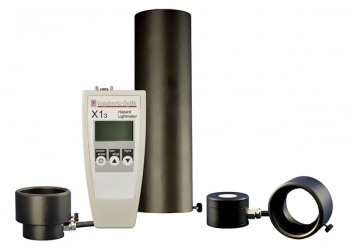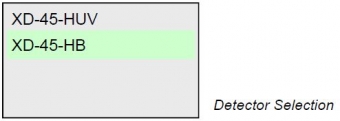Este producto ya no se fabrica. Es posible que queden existencias. Consulte las alternativas que figuran a continuación en "Productos similares" o póngase en contacto con nosotros directamente.
Productos alternativos para este producto descatalogado:
X1-3
Optometer for the measurement of UV and Blue-light hazard of artificial radiation source.
- For usage with XD-45-H type detectors
- compatible to standards IEC/EN 62471 and EN 14255-1
- as well as guidelines 2006/25/EC and IEC TR 62778
- Mobile use
- Battery operation and USB interface

Photobiological Safety Meter
Optical radiation from artificial and natural light sources can effect a photobiological reaction on human skin and eye with the risk of damage due to overexposure. Regulations, standards and guidelines that include effective limit values are published for equipment safety and occupational safety in the workplace. Equipment safety requirements that are internationally agreed on require manufacturer’s to classify, design criteria and warning labels for their products, whereas workplace safety tends to be more national requiring health hazard protection of employees including published exposure limit values, threat analysis and precautionary measures. The most current regulations are:
- IEC 62471:2006 and EN 62471:2008 for equipment safety
- 2006/25/EC guideline and DIN EN 14255-1 for safety of workplaces
- IEC TR 62778:2014 for the assessment of blue light hazard of light sources and luminaires
Integral measurement technology
Gigahertz-Optik GmbH, as a world class manufacturer of high-end filter photometers, colorimeters and radiometers has manufactured light meters for light hazard measurement and assessment since 1992. The early single sensor design of the hazard light meter was later replaced by dual or multi-cell detectors for improved measurement uncertainty (the spectral sensitivity function can be better tuned) and also for simpler operation. The latest design model X1-3 light hazard meter conforms to the 2006/25/EC, IEC 62471, EN 62471, EN 14255-1 and IEC TR 62778 measurement criteria for the evaluation of hazard exposure.
Integral measurement technology vs. double monochromator
The integral measurement technology is a supplemental or alternative measurement method to the double grating monochromator spectroradiometer the most accurate UV radiometric instrument for this application. The double monochromator based instrument is expensive, laboratory based, delicate and includes multiple parts making it difficult to move. Now a portable, hand-held and lower cost solution is available with Gigahertz-Optik’s X1-3 light hazard meter. The complete instrument consists of the compact display unit, XD-45-HB blue light hazard detector and XD-45-HUV UV hazard detector. It is designed specifically for the evaluation of the potential health risk due to exposure from UV and blue light for workplace safety and product classification. Its simple use and price level supports the needs of lamp distributors, light source systems and luminaire manufacturers, institutional and industrial safety engineers, hygienists and others required to perform routine and periodical health hazard optical radiation measurements independently without third party testing laboratories.
Calibration
Gigahertz-Optik GmbH emphasizes that accurate conformal UV and blue light hazard light measurements require a knowledge of basic radiometry, following proper radiometric techniques and understanding the applicable standards! The published CIE 220 approved our way of calibration since we measure the relative spectral sensitivity of each integral sensor. This data can be used for the correction of e.g. the spectral mismatch. This shows that beside know-how in producing such a meter as well a very good equipped calibration laboratory is needed. Gigahertz-Optik can offer both on a highest level, furthermore each device is shipped with a calibration certificate which evidences a traceable calibration back to national standards.
X1-3 Display unit
For on site light hazard measurements in the ultraviolet, blue and visible spectral range Gigahertz-Optik manufactures different detector heads each in multiple sensor design like the most common XD-45-HB and XD-45-HUV. To read out this multi-cell detectors the X1-3 display unit is used, the key features are:
- Four channel electronics for multi-cell detectors
- Wide dynamic range (0.1 pA to 200 µA amplifier)
- Low noise for high sensitivity (0.1 pA resolution)
- Auto ranging gain control
- Four column alphanumeric backlit display
- Powerful microprocessor operation
- Large data storage memory
- Simple to use menu supported operation
- Ergonomic hand-held meter design
- Battery or USB power operation
- USB interface
Quick Operation Guide
After switching on the meter the main menu is opened by pressing the menu button. Depending on the measurement application the UV hazard or blue light hazard detector, connected to the meter, is selected by its model number. The detector calibration data is activated by the enter key and the display is automatically set to the correlating measurement values. If the light source characteristics in the application are not known an average calibration factor is used. A light source emission spectrum dependent measurement uncertainty is factored into the average instruments uncertainty. If the light source can be indisputably identified a light source dependent calibration correction factor can be selected from a library in the menu to reduce measurement uncertainty. The instrument is then ready for actual measurements.

Gigahertz-Optik X1-3 display unit is one of the most compact and ergonomically styled multi-channel light meters available.

X1-3 Detector Selection

X1-3 Source Selection

UV Hazard Display

Blue Hazard Display
Productos similares

